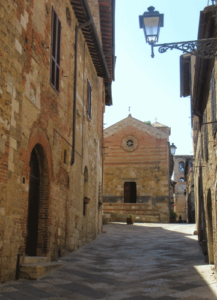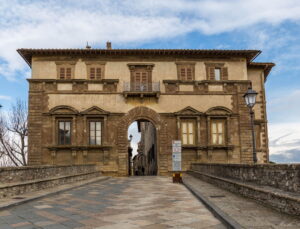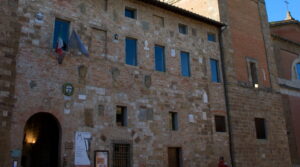In one day you will not be able to see all of Colle Val d’Elsa, of course, but if we have this time it is best not to lose it and follow some advice to make the visit as rich and agile as possible. If you are in Colle Val d’Elsa for the first time, the advice is to go straight to the heart of the city, where the Renaissance and the Middle Ages have coexisted for centuries, in the “Colle Alta”. Let’s start from the fifteenth-century Porta Nuova, here is the ancient village of Santa Caterina, born between the eleventh and twelfth centuries under the first residential nucleus of the Castle. Near the Porta Nuova passage, you can see the installation by the Japanese artist Tadashi Kawamata, made of cypress wood and metal and which replaced the original doors of the door. Continue along Via Gracco del Secco where you will find important buildings: the hospital of San Lorenzo, the monastery of San Pietro and the adjoining church.

At the intersection with Via Porta Vecchia, you can see the massive circular bastion, also known as “Il Torrione“, and the fourteenth-century Ponte dei Frati that connects the settlement with the church of San Francesco, where precious artistic works are preserved. Via Gracco del Secco ends in Piazza Baios which takes us to Via dell’Amore and Via del Refe Nero, where some turreted buildings stand out. Along these streets we are surrounded by stately homes, tower-houses and palaces that were once owned by the prominent families of the city, today in their almost original appearance, thanks to the restorations made between the nineteenth and twentieth centuries. Upon reaching Piazza Santa Caterina, we find the church of the same name where a beautiful sculptural group in polychrome terracotta by the Renaissance artist Zaccaria Zacchi is kept. Continuing along Via del Campana, we reach the Palazzo of the same name among the most important Renaissance buildings present, which connects Borgo and Castello.

Missing the spectacle of walking along via di Castello, the main road, would be unforgivable. Along this suggestive street you can be kidnapped by a silence that takes us back to the past and interrupted only by the screeching of the crows that find shelter in the millenary walls to defend the suggestive tower-houses, among which that of Arnolfo di Cambio stands out. Next to Palazzo Campana you can see the Palazzo Luci, first Palazzo del Capitano then the Florentine keep, and then reach the Bastion of Sapìa, which overlooks the entire valley below with the green area of the Bacìo park that runs along the walls, where a sculpture by the artist Ilya Kabakov is placed. Continuing along via del Castello, you can see in the many stately buildings present, the architectural renovations that took place with the Renaissance, especially in the facades of the Morozzi, Buonaccorsi and Giusti palaces.

The road leads to an open space closed between the buildings, we are in Piazza Duomo, surrounded by the Palazzo del Podestà where the coats of arms of the Podestà, the Duomo and the Palazzo dei Priori, with a particular frieze with cherubs on the facade are still found today in the decorated facade. that make it unique.
This building once housed the historic collections of the Civic Museum and Sacred Art, now merged into the Museum of San Pietro (located in the San Pietro plexus). A stop at the Museum is highly recommended, to get in closer contact with the art and history of this city. From piazza Duomo continue along via del Castello which ends with some medieval turreted buildings. From the Church of Santa Caterina we continued towards the Castle, in the highest and oldest part of Colle Alta, but another road leads up to the Piano, the lower part. Going down the road that leads to the Piano you can admire the Palazzo Susini, the imposing constructions of the Campana bridge (where Porta Passerina once stood) and the nineteenth-century Palazzone. Not far away are the precious archaeological collections of the Ranuccio Bianchi Bandinelli Museum and the former Conservatory of San Pietro designed by Giorgio Vasari. It is needless to underline the importance of the Archaeological Museum which is definitely worth a stop.

Since 2006, the upper part of Colle has been connected to the lower part by a modern ski lift designed by the French architect Jean Nouvel. The advice, however, is to continue on foot, descending the slope that leads from the Baluardo along the road “La Costa”, to Piazza Arnolfo. Here we are in the heart of the modern city, between clubs, shops and the city market on Friday morning. The current appearance of the square is the result of major renovations that took place in the nineteenth century, surrounding the square with large arcades and subsequently with new architectural arrangements given by the architect Jean Nouvel. From Piazza Arnolfo you can continue in the area that was once called the Borgo alle Fabbriche di Sotto. Here today is a new residential complex with a shopping gallery, where the Comi carpentry shop once stood and the first seat of the stucco factory of the Colligiano artist Ferruccio Manganelli. From this position it is easy to reach the Borgo alle Fabbriche di Sopra, along via Maremmana vecchia, up to the paper mill of Buca or walk through the Borgo della Pieve in Piano, where up until a few years ago there were turneries and factories. Continue to the square where the church of Sant’Agostino is located, which houses great masterpieces to be discovered inside, up to the former Boschi area where the first Colligiane glass industries were born and where today the Crystal Museum is located. Unmissable and one of a kind, it is definitely worth a visit, as long as the time at our disposal is not over.
In the lower part of Colle everything becomes more modern, but no less interesting. Squares, monuments, works of contemporary art, art galleries, the theater, former factories perfectly absorbed in revisited urban spaces and nightlife. How to fly over the endless evenings of the Colle Bassa between restaurants for all palates, lounge bars, wine bars, aperitif and night spots that, if they do not find space in your daily visit, will wink at the next one.
Starting from the next article, we will begin to review clubs, restaurants, hotels and pizzerias with a dedicated box, a small selected guide where you can find lots of useful tips and information on how and where to enjoy the best specialties and comforts of Colle Val d’Elsa!
